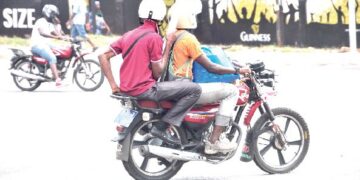Urbanisation has become one of the most defining global trends of the 21st century. According to the United Nations (2018), more than half of the world’s population now resides in urban areas, and this figure is projected to reach 68% by 2050. While this shift presents significant opportunities for economic growth, innovation, and infrastructure development, it also brings complex challenges, particularly in terms of social inequality, spatial fragmentation, and urban insecurity (Eyita-Okon, 2022; Khaliji & Jafarpour Ghalehteimouri, 2024; Sukanya & Tantia, 2023). In the Global South, including much of Africa, urbanisation is occurring at an unprecedented pace, often outpacing the capacity of city authorities to provide adequate housing, public services, and security (Addi & Ayambire, 2022; Kookana et al., 2020). Unlike the historically gradual urban transitions seen in the Global North, many African cities are expanding rapidly in population and spatial size but without commensurate improvements in planning and governance (Curiel et al., 2017; Korah & Wimberly, 2024). This form of fast-paced and often unregulated urbanisation has led to the proliferation of informal settlements, infrastructural deficits, and weakened state control, creating fertile ground for urban crimes (Wa Teresia, 2022).
Projections suggest that Africa’s urban population will triple by 2050, with cities like Lagos, Nairobi, Kinshasa, and Accra emerging as mega urban centers (Kamana et al., 2024). As African cities grow more congested and socially stratified, issues of urban insecurity, including robbery, assault, burglary, and pickpocketing will become increasingly prominent (Yahaya et al., 2025). These crimes not only disrupt social life and economic productivity but also deepen public mistrust and limit the accessibility of public space, particularly for the urban poor.
Within this broader discussion, urban crimes, especially those classified as petty crimes like pickpocketing, have received comparatively limited academic attention. Most existing research on urban security in Africa has focused on violent crime, political unrest, or police brutality, with little emphasis on everyday, non-violent forms of theft that affect thousands of people, particularly in public transport hubs and marketplaces (see Commins, 2011; Elfversson, 2025; Raleigh, 2015). These low-level crimes are often normalised, underreported, and poorly understood, despite their cumulative impact on livelihoods and perceptions of safety in the city.
In Ghana, and in Accra more specifically, pickpocketing has become a pervasive yet under-examined problem, particularly in high-density, transit-oriented spaces like the Madina market and lorry station. While media reports occasionally highlight incidents, yet systematic academic research on the spatial dynamics, tactics, and social implications of pickpocketing remains scarce. There is a need to document how pickpocketing is experienced and interpreted by those who live and work in affected areas and to situate these experiences within broader conversations about urbanisation, informality, and security. This study seeks to fill this gap by examining pickpocketing in Madina, a rapidly growing suburb of Accra. Using qualitative methods such as interviews and participant observation, the research explores the everyday practices of pickpockets, the strategies of vigilance among traders and commuters, and the broader socio-spatial conditions that make such thefts possible.
2. Analytical Framework: The Routine Activity Theory (RAT)
Pickpocketing, typically defined as the stealthy theft of items from a person without their immediate awareness, thrives in dense and mobile urban environments especially in marketplaces, bus terminals, and other crowded spaces (Schlicher & Lurkin, 2024). In cities like Accra, these crimes are often embedded within informal street economies and shaped by spatial configurations that make detection difficult. To analyse the patterns and experiences of pickpocketing in Madina, this study employed the Routine Activity Theory (Cohen & Felson, 1979) as its primary analytical framework. RAT posits that for a crime to occur, three elements must converge in time and space: (1) a motivated offender, (2) a suitable target, and (3) the absence of a capable guardian.
In the context of Madina, the motivated offenders are often unemployed or underemployed youth who operate in and around busy transport and commercial hubs. Suitable targets include unsuspecting commuters, market shoppers, or traders carrying valuables such as mobile phones, wallets, and cash. Absence of guardianship is evident in the limited visible security presence, lack of surveillance infrastructure, and the chaotic spatial arrangements of the lorry park and market.
The Routine Activity Theory helps explain how pickpocketing is not necessarily rooted in the psychology of the offender, but rather in the structure of everyday urban routines and spaces. Crowded lorry stations and markets provide the anonymity, density, and distraction needed for such crimes to flourish. Furthermore, this framework allows for an understanding of how ordinary people adopt protective strategies to compensate for the lack of formal guardianship. It also directs attention to how crime prevention is embedded in urban design, mobility patterns, and informal social monitoring. By applying Routine Activity Theory to the experiences of pickpocketing in Madina, this study situates theft not only as an act of individual misconduct but as a reflection of broader urban vulnerabilities and systemic gaps in public safety and governance.
3. Study Area and Methodology
3.1 Urban Morphology and the Case of Madina
Historically, many cities in post-colonial Africa were structured according to the Concentric Zone Model developed by Ernest Burgess, which conceptualised urban growth as expanding outward in a series of concentric rings from a central business district (CBD) (Chandoke, 1991). In the case of Accra, the colonial city developed around Makola and its immediate surroundings, which served as the administrative and commercial heart of the city. This model influenced the spatial logic of Accra’s early post-independence development, with economic and infrastructural activities radiating from a singular urban core. However, rapid urbanisation, population growth, and spatial sprawl have since restructured this centralised urban form. The once-dominant concentric pattern has given way to more polycentric urban morphologies, better captured by the Multiple Nuclei Model proposed by Harris & Ullman (1945). This model posits that cities do not grow solely from a central core, but rather develop multiple nodes or nuclei, each serving different functions such as commerce, transportation, residence, or industry.
In contemporary Accra, Madina exemplifies one of these emerging nuclei. Situated along the peri-urban edge of the capital, Madina has evolved from a peripheral settlement into a major transportation and commercial hub, serving as a vital point of connection for surrounding communities including Teiman, Oyarifa, Adenta, and parts of the Eastern Region. The area hosts one of the most active bus terminals in the metropolis, with vehicles departing to nearly every part of the city and even extending beyond its boundaries. This centrality in transport logistics and commerce has made Madina an increasingly significant node in Accra’s urban system.
Yet, despite its economic vibrancy, Madina is also marked by security vulnerabilities, particularly around the bus terminal and market area. These dense, high-traffic zones where mobility, commerce, and informal activity intersect have become hotspots for petty crimes such as pickpocketing, posing daily threats to traders, commuters, and passersby alike. The choice of Madina as a case study is thus informed by its strategic urban importance and its complex spatial and social dynamics, which make it a fertile ground for understanding the intersections between informal economies, urban space, and security.
3.2 Methods and approaches
This study adopted a qualitative research design, relying on participant observation and semi-structured interviews to explore the phenomenon of pickpocketing in Madina. The approach was selected to enable an in-depth understanding of the experiences, perceptions, and strategies of everyday actors within the public spaces where these incidents occur.
The data was collected through interviews with ten (10) traders working in and around the Madina lorry station and market. These individuals were purposely selected due to their consistent and long-term presence in the area, which allowed them to observe the tactics, routines, and identities of suspected pickpockets over time. The interviews were conducted in June 2025 and centered on themes such as common tactics used by pickpockets, victim profiles, specific locations and times perceived as dangerous, traders’ personal or observed experiences with theft, and strategies used to prevent or report incidents.
In addition to the interviews, the CISA analyst also engaged in participant observation, spending multiple days in the lorry park and market to observe spatial patterns, foot traffic, and interactions between pedestrians, traders, and suspected offenders. The field engagement was both analytical and personal; the analyst narrowly escaped being a victim of pickpocketing during an earlier visit to the area. This experience heightened the researcher’s attentiveness to the nuanced ways in which vulnerability and alertness manifest in these spaces.
All interviews were audio-recorded, transcribed verbatim, and analysed using thematic analysis. This method involved coding the data to identify recurring patterns and categories, which were then interpreted in relation to the broader research objective and theoretical framework. The analysis was guided by Routine Activity Theory, which foregrounds the spatial and temporal conditions under which crimes occur. Themes that emerged included offender tactics, victim behavior, spatial vulnerability, and community responses. Ethical considerations were carefully observed. Verbal consent was obtained from all participants, anonymity was assured, and interview data was handled confidentially.
4. Results and Discussions
The thematic analysis of interviews with traders in Madina revealed several recurring patterns and insights into the dynamics of pickpocketing in this rapidly urbanising node. Three core themes emerged from the data: (1) Tactics and Methods of Pickpockets, (2) Victim Profiles and Vulnerabilities, and (3) Perceptions of Urban Insecurity and Strategies of Resistance. Each theme is discussed below in light of the Routine Activity Theory, which frames the convergence of motivated offenders, suitable targets, and the absence of capable guardianship in producing urban crime.
4.1 Tactics and Methods of Pickpockets
Participants consistently described pickpockets in Madina as highly strategic, calculated, and often unassuming. Their tactics rely on stealth, distraction, and physical proximity, especially in crowded settings like the lorry station and market. A female trader who has been selling in the market for over a decade said:
These pickpockets are smart. They robbed one of my customers. They are so fast. They will intentionally bump into you and steal from you and you will never know until you get home. (Trader 1, June 2025)
The use of deliberate physical contact such as bumping into victims or brushing against them serves to distract attention and create opportunities for theft. This aligns with Routine Activity Theory: motivated offenders exploit moments of routine distraction, especially when victims are preoccupied with travel, purchasing goods, or navigating through crowded terminals. Additionally, some offenders deploy social camouflage by blending into their surroundings. This includes posing as fellow customers, acting like bystanders, or dressing in respectable clothing to avoid suspicion. This view was expressed by a 52-year-old tomatoes seller:
They are not just the young dirty men you see, some are actually looking responsible. Some are even women. They will pretend that they are also buying something from the person you are buying from, get closer to you and steal from you. (Trader 5, June 2025)
Such performances of normalcy make detection difficult, as guardians (such as traders or passersby) may not easily distinguish a potential offender from a legitimate customer.
4.2 Victim Profiles and Spatial Vulnerability
The interviews revealed that pickpockets do not limit their activities to transient commuters; even stationary actors like market traders are vulnerable. One 34-year-old secondhand cloth seller stressed that: “They do not steal from passersby, they steal from us too. I was once a victim; they stole all my sales for that day. I struggled to pay those I was owing.” (Trader 8, June 2025)
Victims are often individuals carrying bags, especially backpacks or handbags that are worn behind or to the side. One trader said “One day, I saw someone opening the backpack of someone. Backs bags are easy to open without you noticing. I had to shout ‘thief, thief!’ and he ran away.”| These configurations make them suitable targets, particularly when the bags are unzipped or loosely secured. The spatial design of Madina, with its congested walkways, unregulated vending spaces, and high pedestrian density, compounds the risks. The absence of formal surveillance systems such as CCTV or visible police presence reflects the lack of capable guardianship identified by Routine Activity Theory.
4.3 Perceptions of Insecurity and Strategies of Resistance
The repeated exposure to theft and the visibility of suspicious behavior has cultivated a collective sense of caution among traders and frequent users of the space. One trader said “People need to be careful in Madina. Madina is not safe at all. You have to hold your possessions very well. If you make loose, you will lose everything.” (Trader 3, June 2025). Another added that:
We must all be vigilant. They don’t have mercy. You must put your belongings into a place that they will find difficult to reach, and you must look sharp and be observant. If you see someone being too close to you, you must be wise. (Trader 9, June 2025)
These insights suggest that local knowledge and alertness have become informal substitutes for formal protection mechanisms. Traders often take on the role of guardians by warning customers or shouting to alert others, as seen in the case of Trader 2. However, this informal surveillance system is not always reliable or sustainable. The normalisation of insecurity and the constant threat of theft have implications for urban trust, economic activity, and spatial behavior. Some traders described feelings of frustration, helplessness, and fear. The recurrence of theft incidents, even in the presence of long-time traders, points to systemic governance and planning failures in the management of public commercial spaces.
5. Recommendation and conclusion
Based on the findings of this study, it is evident that pickpocketing in Madina is not simply a product of individual deviance, but rather a reflection of wider urban governance, planning, and security deficits. The following recommendations are made to enhance safety and reduce incidences of theft in Madina and similar urban spaces:
- The Public education campaigns through local radio, television adverts posters at the lorry station, and community announcements should sensitise commuters and traders about common pickpocketing tactics. Special emphasis should be placed on bag safety, such as advising people to wear backpacks in front when in crowded areas, zip up bags and avoid displaying valuables openly and avoid using phones while walking in crowded terminals.
- The physical layout of Madina’s lorry park and market contributes to vulnerability. Simple infrastructural changes such as creating clear walking paths, reducing congestion, and improving lighting can make it harder for pickpockets to operate unnoticed. Urban authorities should collaborate with local vendors to decongest certain hotspots and improve pedestrian flow.
- The deployment of visible security personnel even in shifts during peak hours can serve as a deterrent. Additionally, installing CCTV cameras in strategic parts of the lorry terminal and market could assist in identifying repeat offenders and enhancing accountability.
- Several participants hinted that many of the pickpockets are young, unemployed people. While security interventions are necessary, long-term solutions must address economic marginalisation and the lack of opportunities for urban youth. Government programs targeting skills development, apprenticeship, or entrepreneurship in areas like Madina could help redirect vulnerable youth away from petty crime.
In conclusion, this study has examined the phenomenon of pickpocketing in Madina, a key urban nucleus within the Greater Accra Metropolitan Area using qualitative interviews and thematic analysis grounded in Routine Activity Theory. The findings show that pickpocketing is both widespread and sophisticated, enabled by crowded spaces, lack of surveillance, and the unsuspecting behavior of pedestrians. While often dismissed as minor theft, pickpocketing erodes public trust, affects livelihoods, and undermines urban security. The testimonies of traders revealed the emotional and economic toll of these crimes and highlighted the resilience and vigilance required to navigate such high-risk environments. In understanding Madina not just as a transport hub but as a dynamic urban center marked by both opportunity and precarity, this study sheds light on broader urban security challenges in postcolonial African cities undergoing rapid transformation. Future research could explore how informal surveillance practices evolve in response to crime, and how urban planning can be made more responsive to everyday vulnerabilities. Ultimately, making cities safe is not only about policing but also about inclusive planning, community engagement, and social investment, especially in overlooked but significant nodes like Madina.
Reference
Addi, B., & Ayambire, R. A. (2022). Neoliberalism and the growth of slums in Accra, Ghana. SN Social Sciences, 2(11). https://doi.org/10.1007/s43545-022-00558-7
Chandoke, N. (1991). The Post-Colonial City. Economic and Political Weekly, 26(50), 2868–2873. http://www.jstor.org/stable/4398397
Cohen, L. E., & Felson, M. (1979). Social Change and Crime Rate Trends: A Routine Activity Approach. American Sociological Review, 44, 588-608. http://dx.doi.org/10.2307/2094589
Commins , S. (2011). Urban Fragility and Security in Africa – Africa Center. africacenter.org. July 14, 2025. https://africacenter.org/publication/urban-fragility-and-security-in-africa/
Curiel, R. P., Heinrigs, P., & Heo, I. (2017). Cities and spatial interactions in West Africa. West African Papers.
Elfversson, E. (2025). Contentious cities? Urban growth and electoral violence in Africa. World Development, 193, 107066. https://doi.org/10.1016/j.worlddev.2025.107066
Eyita-Okon, E. (2022). Urbanization and human security in post-colonial Africa. Frontiers in Sustainable Cities, 4. https://doi.org/10.3389/frsc.2022.917764
Harris, C. D., & Ullman, E. L. (1945). The Nature of Cities. The ANNALS of the American Academy of Political and Social Science, 242(1), 7-17. https://doi.org/10.1177/000271624524200103
Kamana, A. A., Radoine, H., & Nyasulu, C. (2024). Urban challenges and strategies in African cities – A systematic literature review. City and Environment Interactions, 21, 100132. https://doi.org/10.1016/j.cacint.2023.100132
Khaliji, M. A., & Jafarpour Ghalehteimouri, K. (2024). Urban security challenges in major cities, with a specific emphasis on privacy management in the metropolises. Discover Environment, 2(1). https://doi.org/10.1007/s44274-024-00116-3
Kookana, R. S., Drechsel, P., Jamwal, P., & Vanderzalm, J. (2020). Urbanisation and emerging economies: Issues and potential solutions for water and food security. Science of The Total Environment, 732, 139057. https://doi.org/10.1016/j.scitotenv.2020.139057
Korah, A., & Wimberly, M. C. (2024). Smaller cities have large impacts on West Africa’s expanding urban system. Sustainable Cities and Society, 106, 105381.
Raleigh, C. (2015). Urban Violence Patterns Across African States. International Studies Review, 17(1), 90–106. http://www.jstor.org/stable/24758380
Schlicher, L., & Lurkin, V. (2024). Fighting pickpocketing using a choice-based resource allocation model. European Journal of Operational Research, 315(2), 580-595. https://doi.org/10.1016/j.ejor.2023.12.007
Sukanya, R., & Tantia, V. (2023). Urbanization and the Impact on Economic Development. Advances in Logistics, Operations, and Management Science, 369-408. https://doi.org/10.4018/978-1-6684-9261-1.ch019
United Nations ,. (2018). 68% of the world population projected to live in urban areas by 2050 .. https://www.un.org. July 14, 2025.https://www.un.org/uk/desa/68-world-population-projected-live-urban-areas-2050-says-u
Wa Teresia, J. N. (2022). Awareness, Attitudes and Perceptions of Safety among Slum Residents in Nairobi, Kenya. East African Journal of Arts and Social Sciences, 5(1), 154-173. https://doi.org/10.37284/eajass.5.1.651
Yahaya, O. Y., Gyang, D. D., & Jeje, O. G. (2025). Spatial pattern and determinants of crime incidence in urban neighborhoods of katsina city, nigeria. FUDMA JOURNAL OF SCIENCES, 9, 128-135. https://doi.org/10.33003/fjs-2025-09(ahbsi)-3408






























